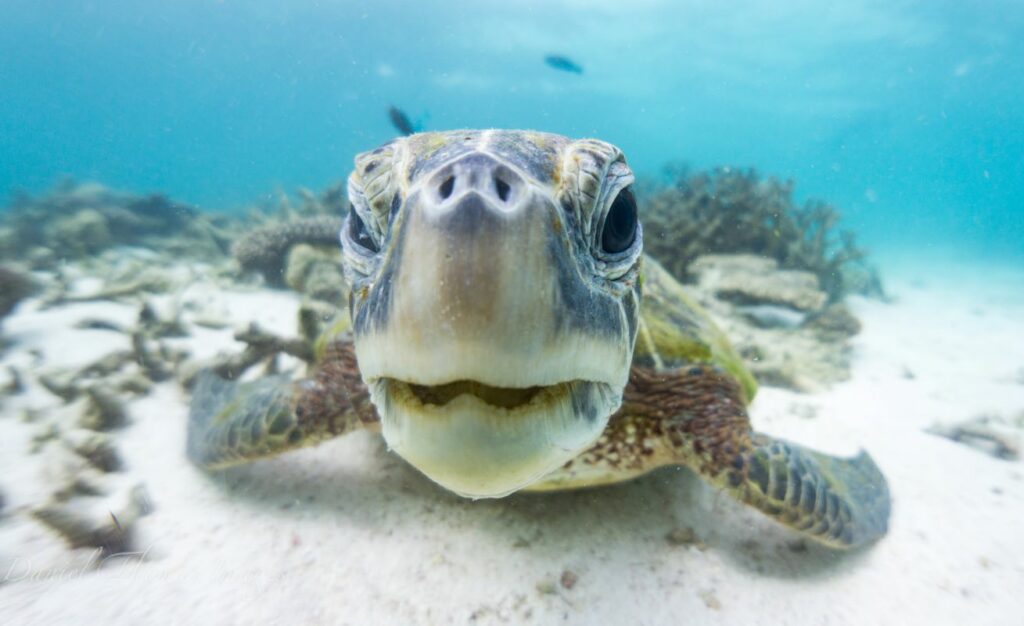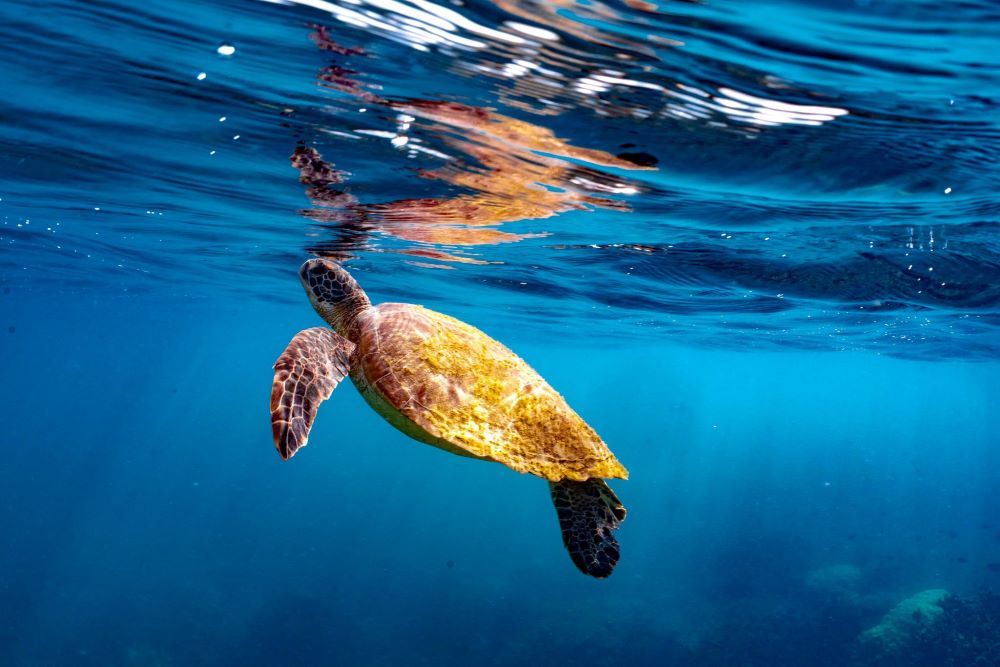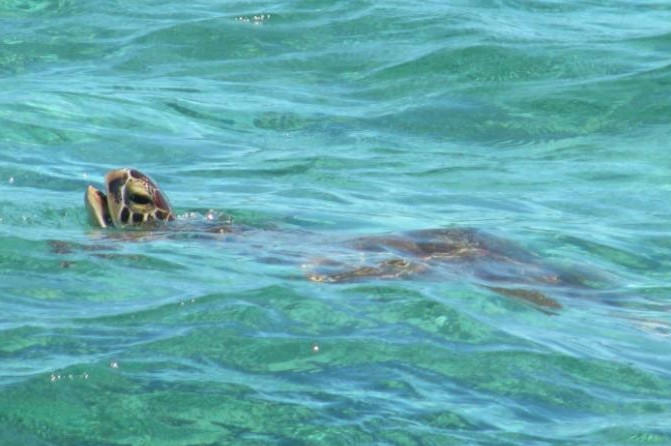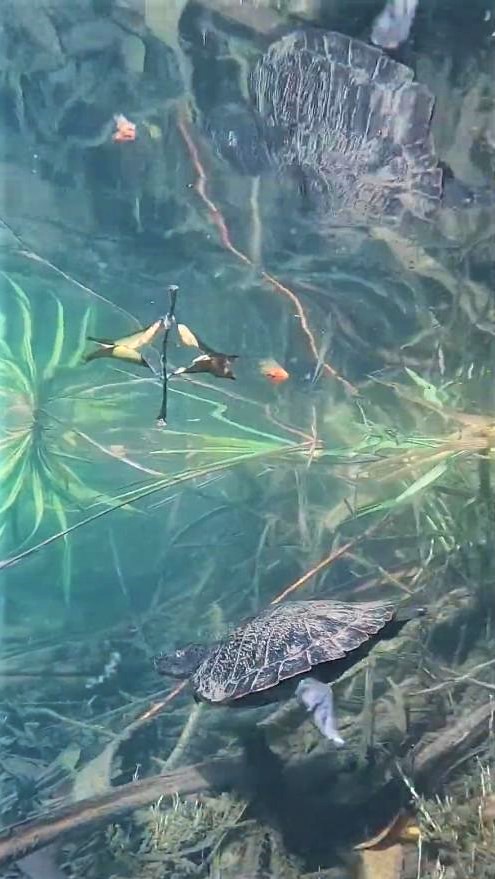Swimming with turtles is one of the best snorkelling experiences you can have, and the good news is that there are lots of places where you can swim with turtles in Australia. Because turtles can even be quite inquisitive, you can get up close if you let them come to you. And of course, they are incredibly endearing creatures, so seeing one can be the highlight of your snorkelling trip.
We have been fortunate enough to swim with turtles all around Australia so have put together a guide to some of the best places to see them. We include details of what you might see and a few tips from our experience at the different locations.
We have also listed turtle tours for each location where local guides know the best spot to swim with turtles and see turtle nesting sites.
Disclosure: Please Note That Some Links In This Post May Be Affiliate Links, And At No Additional Cost To You, We Earn A Small Commission If You Make A Purchase. Commissions Go Toward Maintaining The Curious Campers Website.

Where can you swim with turtles in Australia?
Queensland, New South Wales, and Western Australia all have spots where you can swim with turtles. The Great Barrier Reef and Ningaloo Reef are fantastic places to get up close to a turtle in the wild.
While the Northern Territory is home to all the sea turtle species in Australia, the presence of crocodiles makes swimming with them unsafe. You can safely swim with freshwater turtles in the Northern Territory and see nesting sites.
Australian island territories like the Cocos Island, Christmas Island and Lord Howe Island are also good places to swim with turtles – as well as being amazing places to visit.
What turtles can you swim with in Australia?
If you like swimming with turtles, Australia is a great place to do it as 6 out of the 7 species of marine or sea turtles can be found in Australian waters. The Green Sea Turtle, Hawksbill Turtle and Loggerhead Head Turtle are the most common. But you might also come across the Leatherback Turtle, Olive Ridley Turtle and Flatback Turtle.
The one turtle you won’t swim with in Australia is the Kemps or Atlantic Sea Turtle, these are found on the east coast of America.

Swim with Turtles in Western Australia
Ningaloo Reef runs for 260km along Western Australia’s Coral Coast Between Coral Bay and Exmouth. The drive there from Perth to Exmouth is one of Australia’s best road trips. Sea turtles come to the reef to feed and breed making Ningaloo a great location for swimming with turtles. Because the reef can get as close as 50m to the shore, you can snorkel with turtles right off the beach, here are some of the best places on Ningaloo Reef to swim with turtles.

Coral Bay
Turtles: Green Turtles are the most common, but you will also find Loggerhead & Hawksbill
We Spotted: Green Turtles – lots of them!
Where: Coral Bay Drift Snorkel, Five Fingers Reef, Turtle Sanctuary
On our first drift snorkel in Coral Bay an enormous Green Turtle joined us, following us over the coral gardens and into the bay. It was the first turtle we had swum with, and we couldn’t take our eyes off it. On our return trip to Coral Bay, we again encountered turtles on the drift snorkel. We also found a couple of turtles at Five Fingers Reef, here they didn’t hang around for long, but it was still nice to see them. Coral Bay offers a nice-sheltered location for families to snorkel right from the beach.

Exmouth
Turtles: Green, Loggerhead, Hawksbill, Flatback Turtles
We Spotted: Green Turtles
Where: Ningaloo Reef – Turquoise Bay & Lakeside Sanctuary Zone
Exmouth is recognised as one of the world’s most important nesting grounds for Green Sea Turtles and Loggerhead Turtles. Nesting season is from November to March where you can watch the turtles drag themselves up the beach to lay their eggs. Six weeks after laying the eggs, they hatch and the tiny turtles make their way into the ocean. Visit the Jurabi Turtle Centre to learn about sea turtles and join a guided tour between December to January.
We snorkelled at most of the Ningaloo Reef sites along Cape Range National Park. We saw turtles frequently at Turquoise Bay and Lakeside Sanctuary Zone, but you’ll also see them at the Oyster Stacks, Osprey Bay and South Mandu Beach. Keep your eyes peeled as sometimes they are resting under ledges or feeding on jellyfish, or they will just swim alongside you.
Turtles in the Indian Ocean Territories
If you want a holiday with a difference, think about exploring Australia’s Indian Ocean Territories of Christmas Island and the Cocos Islands. They form part of the Indian Ocean Territory Marine Park which has unbelievably good snorkelling and diving. Besides the dolphins, manta rays, whale sharks and a myriad of tropical fish, the islands are also a great place to swim with turtles.

Cocos (Keeling) Island
Turtles: Hawksbill, Green, Olive Ridley, Loggerhead & Leatherback Turtles
We Spotted: Hawksbill & Green Sea Turtles
Where: Pulu Maraya Island, Snorkelling with CocosDay, Direction Island & West Island Foreshore
Turtles are regularly spotted in the shallow waters around Pulu Maraya Island. While they eluded us on our snorkels there, we saw plenty of tropical fish, reef sharks and an eel and octopus in the crystal clear water.
Off-shore snorkelling on a boat with CocosDay we saw a couple of Hawksbill turtles feeding on the reef. This reef was also home to the biggest clam we had ever seen. Green Sea Turtles nest nearby at the remote Pulu Keeling National Park.
If you are keen to stay dry and see turtles, on West Island, walk along the foreshore near Saltmakers Restaurant on a high tide. From your view a few metres above the water you can see huge green turtles and loggerhead turtles pop up all along the coast, some just metres from shore. Swimming in between the turtles and along the shoreline you will also spot juvenile black tipped reef sharks.
We did try to jump in to swim with them but being on the ocean side of the lagoon the water was a bit stirred up and at water level it was much harder seeing them. The best experience is definitely spotting them from the seawall.
Read More >>> Snorkelling Cocos Islands

Christmas Island
Turtles: Hawksbill & Green Turtles
We Spotted: Hawksbill Turtles
Where: Flying Fish Cove, Dolly & Greta Beaches
Flying Fish Cove has a resident Hawksbill Turtle named Cedric who seems happy for some company and regularly poses for selfies. Flying Fish Cove is just like swimming in an aquarium – you will see more fish than you can ever imagine.
We enjoyed a day trip out to Dolly Beach, following the boardwalk through the jungle. Green Sea Turtles nest here all year round. Each morning you can see the fresh tracks from where the turtles have dragged themselves up onto the beach to lay their eggs. You can get a camping permit to stay overnight but be prepared to stay awake until the early hours of the morning if you hope to see them.
Read More >>> Snorkelling & Diving on Christmas Island
Swimming with Turtles in Queensland
The Great Barrier Reef needs no introduction, one of the seven wonders of the natural world is of course a brilliant place to swim with turtles. Green sea turtles and loggerhead turtles are most common. From Lady Elliot Island in the south to Fitzroy Island in the north of the reef, there are lots of tours that can get you swimming with turtles. You can also find yourself swimming with turtles in the Whitsundays and as far south as Morton Island.

Great Barrier Reef
Turtles: Green Sea Turtles
We spotted: Green Sea Turtles
Where: The Great Barrier Reef has multiple reefs to explore. Depart from Cairns, Port Douglas or Cape Tribulation
Head out on a charter to experience colourful and diverse underwater world of the Great Barrier Reef. Depending on conditions you will have the chance to get in the water on a couple of locations. With plenty of tropical fish, pristine coral formations, rays, turtles and “nemos”, you’ll be blown away by beauty of the Great Barrier Reef.

Fitzroy Island
Turtles: Green Sea Turtles
We spotted: Green Sea Turtles
Where: White Rock Snorkel Site
Finding turtles and coral on Fitzroy Island is almost guaranteed if you know where to look! With much of the islands reef damaged, your best bet is to head to the location known as White Rock. When approaching the island, White Rock is to the left of the jetty, and recognisable as a boulder covered in guano (bird poop).
Around the point, you will find huge 1m+ plate corals, thriving hard and soft corals and a population of green sea turtles of all shapes and sizes. We spotted 4 turtles during our snorkel, and they were used to people and didn’t mind you swimming with them!
Reaching White Rock does require a level of fitness and swimming confidence and is only recommend in calm weather conditions.
Read More >>> Snorkel Fitzroy Island


Palm Cove – Double Island
Turtles: Green & Hawksbill Turtles
We saw: Green Sea Turtles from the kayak
Where: On route and from the beach.
A popular day activity when in the Cairns Region is to jump on a kayak tour, or hire/ BYO kayak and make the 3km return paddle to Double Island and its little neighbour, Scout Hat Island. Sitting in a kayak gives you a great vantage point and you are guaranteed to see turtle heads popping out of the water as they take a breath.
Double Island is privately owned, and is home to an abandoned resort, a caretaker and his two friendly dogs. visitors are welcome to land and explore the island up to the high tide mark, perfect for picnicking and spotting stingrays and turtles in the shallows.
With the dense coral situated between Scout Hat and Double Island, if you are going to snorkel, this is where it’s at! You can expect to see huge Giant Clams, Blue Spotted Stingrays, little reef sharks and if you’re lucky you might spot a shy green turtle!
Watch the tides as at Low Tide the reef is exposed making snorkelling and kayaking difficult. Visibility fluctuates here, the best conditions are often after a few days of no wind or rain.
Lady Elliot Island
Turtles: Green, Loggerhead & Hawksbill Turtles
We saw: Green, Loggerhead & Hawksbill Turtles
Where: All around the island!
Lady Elliot Island sits at the Southern End of the Great Barrier Reef and is world renowned for its incredible marine life. The island not only has resident turtles, but it is also a nesting site for several turtle species meaning from November to January, the waters are swarming with frisky turtles. It was not uncommon to see the turtle traffic jam underwater with two or three turtles within arm’s reach at any time!
Green and Hawksbill turtles can be seen on all sides of the island, with the youngsters and smaller female turtles entering the Eastern shallow lagoon to feed on seagrass at high tide.
Green and Hawksbill are also on the Western side of the island all day. Here you are more likely to see mature males and females and they can be enormous!
For the more adventurous, Lady Elliot Island offers scuba diving, which is a great chance to get up close with huge Loggerhead Turtles, recognisable by their chunky necks, who tend to cruise at deeper depths. Consider doing a night dive to see sleepy turtles resting under coral ledges, or on the sandy seafloor!
With Lady Elliot’s focus on protecting its marine life, the turtles here have no fear, and happily cruise alongside and take selfies with swimmers.
From November to January, Lady Elliot Island encourages guests to walk the beaches and observe mother turtles dig nests and lay their eggs, and January to March offers the chance to see the hatchlings emerge from the sand and make their dash for the waters-edge.

Heron Island
Turtles: Loggerhead & Green Sea Turtles
We saw: Loggerhead & Green Sea Turtles
Where: Ganty Bay, Shark Bay & HMAS Protector Wreck
Heron Island is a significant nesting and hatching site for both the Green and Loggerhead Turtles. Nesting occurs from November to March with hatchlings emerging from early January. You can join the Naturalist Guides on a complimentary guided turtle walk to hear all about the lifecycle of these amazing creatures and ensure their safety and survival.
You can swim with turtles year round on Heron Island, but they will be more prolific during nesting season. Snorkel straight off the beach. At high tide you will find turtles in Ganty Bay and Shark Bay. At high tide you can snorkel the HMAS Protector wreck (visible from the Jetty). The turtles use the wreck and coral gardens as a cleaning station to get parasites off their shells.
You cannot swim around the Jetty between 8am-5pm due to boat traffic so check the tide times and plan your best times to snorkel.
There are no Heron Island day trips so you will need to stay overnight (or a few days) to explore the Island.

Whitsundays
Turtles: All turtles that live around Australia, Green Sea Turtles are most common
We saw: Green Sea Turtles
Where: Stonehaven Bay, Hook Island
When researching the best snorkel sites amongst the Whitsundays Islands we were recommended many from Manta Ray Bay & Stonehaven Bay, Hook Island and Chance & Tongue Bay on Whitsunday Island to name a few! When considering snorkelling sites, it’s important to pick a bay sheltered from the wind, we chose Stonehaven Bay and we’re not disappointed!
We traced the edge of the coral shelf about 40metres off the beach and spotted cruising green sea turtles, huge opal coloured Māori wrasse and schools of reef fish at every turn!
You can book a sightseeing tour and let them do the work for you or hire your own boat and explore the islands at your own pace. Whilst the islands offer diverse snorkelling, for better visibility and healthier reefs you can take a scenic flight or boat tour out for an outer reef experience.


Lake Eacham
Turtles: Saw Shelled Turtles – Freshwater
We saw: Saw Shelled Turtles
Where: Between the Turtle Viewing Deck & swimming access point.
A very popular day spot, Lake Eacham offers something for everyone. A volcanic crater lake, Lake Eacham is perfect for hiking, swimming, kayaking and picnicking. It’s not uncommon to see the lake dotted with colourful noodles, kids splashing in the shallows, families walking the boardwalks and kayakers doing laps of the lake.
Lake Eacham is rich with freshwater turtles, with the more unusual Saw Shell Turtle common here. Lake Eacham offers a turtle viewing platform where you can often sight turtles basking in the sun perched on logs.
However, if you want to swim with turtles then grab your snorkel and swim between the swimming access and turtle viewing platform. There is no need to venture far, they are in less than a metre of water camouflaged amongst the reeds. Turtles can also be sighted deeper as they navigate the underwater root systems.
It is important to exercise caution when snorkelling at Lake Eacham, there are lots of fallen trees and debris underwater that can pose entanglement risks. Not only this but there is a warning of a freshwater crocodile that, whilst timid, does reside in Lake Eacham.
Swimming with Turtles in New South Wales

Cook Island
Turtles: Green, Loggerhead & Leatherback Turtle
We saw: Green Sea Turtles
Where: Cook Island Marine Reserve just off the coast near Tweed Heads
Not to be confused with the Cook Islands in the South Pacific, this Cook Island is about 600m off the coast near Tweed Heads. The best way to get out here is on a tour, conditions around Cook Island can be quite different to those near the shore and, so depending on the day, tour operators know the best spot to drop you in the water.
Cook Island is home to a resident population of Green Sea Turtles. For our tour, we got in the water at the northern end of the island, snorkelled near the reef and there they were – half a dozen or more big green turtles. They were in 2 – 3 metres of water and completely unbothered by us swimming around. We sat over them and snorkelled next to them for about an hour before moving to the other end of the island.
We ‘only’ saw a couple of turtles here, but also briefly spotted a manta ray and a huge number and variety of fish. Some of the less experienced snorkellers on the tour found the conditions a bit challenging as you are quite exposed, and the sea can be lumpy so pick your days to head out to Cook Island. There were also divers on the trip and down deeper they spotted some enormous green turtles too. If you are on the Gold Coast or in the Tweed, a trip out to Cook Island is a fantastic snorkelling adventure.

Byron Bay
Turtles: Green & Hawksbill Turtle
We saw: Green Sea Turtles
Where: Julian Rocks Marine Reserve or Clarkes Beach
Julian Rocks is popular for both snorkelling and scuba diving. You will see turtles year round, during the winter months you might see grey nurse sharks and in summer manta rays. A tour is the best way to get out to the Marine Reserve and ensure the best location to find turtles. During the winter months you might be lucky enough to see whales from the boat.
Clarkes Beach is a quieter beach and turtles can often be seen just a few steps from the shore. At Clarkes Beach aim for high tide for improved visibility.
Swimming with Turtles in the Northern Territory
6 out of the 7 species of marine turtles found in the world are found in Northern Territory waters. Guided tours are available from Darwin to turtles nesting sites on Bare Sand Island. Flatback Turtles and Olive Ridley turtles visit the island to nest. Due to salt-water crocodiles swimming in the ocean is not possible so it is beach or boat viewing only.
For a much safer experience, you can swim with freshwater turtles at Bitter Springs or Howard Springs.
Bitter Springs
Turtles: Cann’s Snake Necked Turtle & Northern Australian Snapping Turtle – Freshwater
We saw: Cann’s Snake Necked Turtle
Where: Bitter Springs Drift Snorkel
Bitter Springs boasts turquoise waters sitting at a balmy 34 degrees. It is a flowing river, so perfect for a relaxing drift as you soak in the scenery above and below the waterline.
Fringed with palm trees and algae, you would expect visibility to be average, but Bitter Springs is crystal clear as far as the eye can see!
You will need a snorkel and mask to spot the freshwater turtles and fish cruising by and darting out along the riverbanks. Whilst turtles can be spotted all day long, they are most active at sunrise and sunset, at either end of the day we spotted more than we could count!
If you want Bitter Springs to yourself, sunrise and sunset is the time to be there, with peak times from 9-4pm with tourists flocking to see beautiful area.
- Swimming with Turtles in Australia - October 29, 2023



